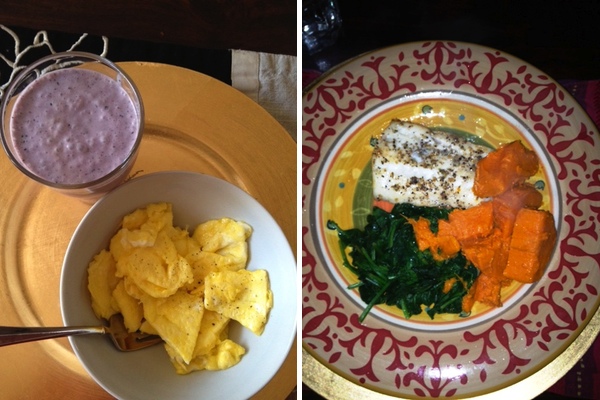A smoothie and eggs for breakfast and fish, sweet potatoes, and greens are just some of the meals the author creates for her Paleo lifestyle. Photographs by Ann Wendel.
My last post described my story of using the principles of a Paleo diet as just one way to treat my autoimmune thyroid condition, Hashimoto’s disease. Since then, a lot of you have asked me how to actually implement these changes in your own lives. While you should consider consulting your doctor first before making changes to your meal plan, read on to find out what it takes to live a Paleo life.
Paleo is short for Paleolithic and refers to a lifestyle and eating plan similar to that of our pre-agricultural ancestors. This is a way of living that gets back to eating good, whole foods that are gluten-, grain-, and legume-free, with little to no dairy.
As with any lifestyle change, you’ll most likely find it difficult cutting out processed foods and carbohydrates at first. I recommend strict adherence to the principles for 30 days as a “reset.” That means 30 days with no cheating in order to evaluate your body’s response to the changes in diet.
Think you’re ready to take this on? Here are my five tips for implementing the Paleo lifestyle.
1) Go gluten-, grain-, and legume-free.
You may be asking yourself, “Why would I want to give up my healthy whole grains along with my bagels, Krispy Kremes, and pizza?” Because whole grains are proven gut irritants. Wheat germ agglutinin can damage our intestinal lining and cause inflammation, which can then lead to celiac disease, diabetes, rheumatoid arthritis, hypothyroidism, and lots of other nasty diseases. Following a gluten-, grain-, and legume-free eating plan can prevent you from acquiring or significantly reduce the often painful symptoms of the disease and can help heal your gut.
2) Incorporate smart exercise/movement into your life.
Along with the eating plan, a Paleo lifestyle involves exercise. Typical exercises include walking, hiking, climbing, paddling, biking, and weight-lifting. I personally do a lot of bodyweight training, rock climbing, and natural movement. You want to move all of your joints through the full range of motion every day, but don’t go overboard. The body needs time to recover and rest between workouts.
3) Get good, quality sleep every night.
This means eight hours in a totally dark room. Buy blackout shades and earplugs if you need to. Your body needs to regulate sleep and wake cycles as part of your 30-day experiment.
4) Start using techniques to decrease stress.
Prolonged or severe stress can weaken the immune system, contribute to autoimmune illnesses, damage the heart, decrease memory, put you at risk for depression and anxiety, and cause the deposit of fat around the belly. Say no to unnecessary commitments, turn off phones and e-mail for an hour before bedtime, practice yoga or meditation, and set boundaries in relationships.
5) Slay the sugar dragon.
Eliminate processed foods and sugary snacks from your diet. Decrease or eliminate alcohol consumption, since many cocktails are loaded with sugar and alcohol interferes with sleep patterns. Cut down to one cup of coffee a day with minimal to no sugar.
For more information, visit my blog, which details my own 30-day Paleo challenge in January 2012.
Ann Wendel is a certified athletic trainer, a licensed physical therapist, and a certified trigger-point therapist. The information in this article is from the author’s own experience. This information is not intended to diagnose or prescribe treatment of any kind. Please consult your physician regarding any medical issues you may be having.



















